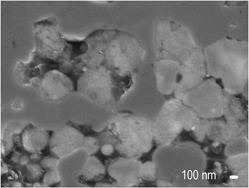Published online by Cambridge University Press: 15 June 2017

Dense ZrB2–SiC nanocomposites were fabricated at 1450 °C by the high-energy ball milling (HEBM) of ZrB2 powder with ZrSi2–B4C–C additives and reactive spark plasma sintering (R-SPS). The sizes of ZrB2 and SiC grains were 80–350 nm, and the phases were homogeneously distributed because of the molecular-level homogeneity of the constituents in ZrSi2 and the homogeneous mixing of the raw powders by HEBM. The deformation of ZrSi2 or the reactions between the additives during R-SPS did not strongly promote the densification. Fine and homogeneously distributed ZrB2 and SiC particles formed by HEBM and R-SPS were the major reasons for the low temperature densification. The fine particles which had high surface energy provided the driving force for densification at low temperatures. Also, the fine SiC grains suppressed the growth of ZrB2 grains during densification. The 4-point bending strength of the composites sintered at 1500 °C was 354 MPa.
These authors contributed equally to this work.
Contributing Editor: Xiaowei Yin